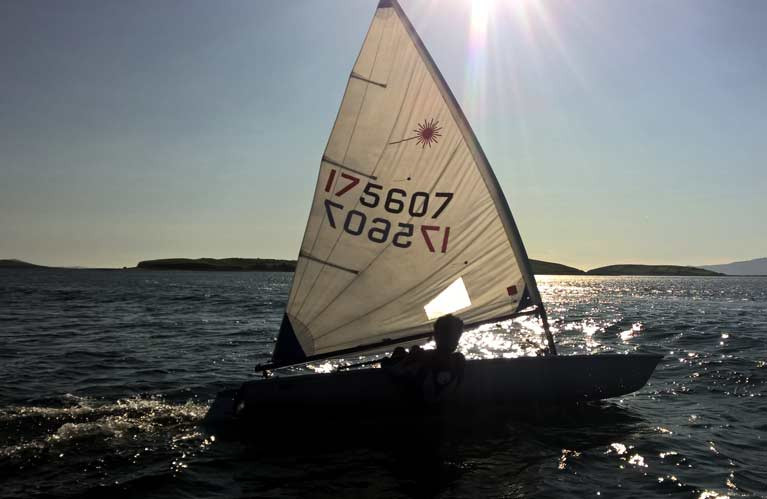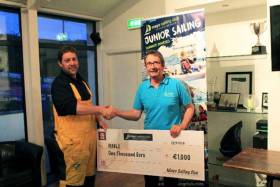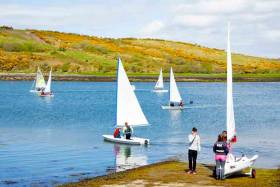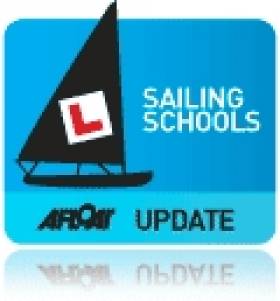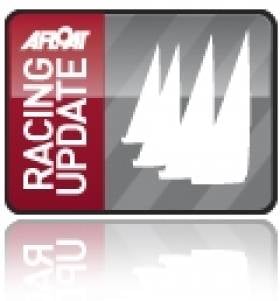Displaying items by tag: Mayo Sailing Club
The J24 Northern Championship, hosted by Mayo Sailing Club, saw 14 teams from around the country compete in six races over the weekend of 27th and 28th May. The event was raced in moderate winds and sunshine against the picturesque surroundings of Clew Bay.
The overall winner was Headcase, who scored four firsts and a second in the six races. The crew was Louis Mulloy, Marcus Ryan, Cillian Dickson, Ryan Glynn and Ronan Armstrong.
The second place went to Janx Spirit, skippered by Tadgh O Loinsigh from Tralee Bay Sailing Club, who also finished second place to Headcase in the 2022 National Championships.
The third place was claimed by Hedgehog, sailed by Mark Usher and his crew from Greystones Sailing Club, improving on their fourth-place finish in the Western Championships at Lough Ree Yacht Club last month.

It was the first time Mayo Sailing Club have hosted the J24 fleet, and both the sailing and social side didn’t disappoint. The race committee, led by principal race officer Derek Bothwell, efficiently ran six races in good breeze and some challenging chop against the backdrop of a sunny Croagh Patrick.
Following lift-in and one slip-launched late-comer on Friday, crews were treated to a welcome feast of local Clew Bay mussels.
Live music and a great spread of Mediterranean-inspired food on Saturday evening went down well with sailors after a long day on the water in what could have been Costa del Mayo.
Four races were sailed on Saturday, with Headcase taking the first race win, followed by Hard on Port, helmed by Dave Bailey, in second and Hedgehog in third. Hedgehog excelled again in race 2, taking the race win in lighter breeze, with Janx Spirit in second and Jelignite in third.

The final two races of the day saw Headcase, Hard on Port, and Janx Spirit share the podium, leaving Headcase with a narrow overnight lead, ahead of HoP and Janx.
Day 2 was raced in a shifty offshore breeze. Headcase, HoP and Janx broke away from the rest of the fleet in race 5, trading places around the first lap before the tricky conditions allowed them to be reeled back in. Headcase held on for the race win, wrapping up the event with a race to spare to the delight of local spectators. Class stalworth JP McCauldin on Il Riccio got in for second place, with Diarmuid Mullen on Smugairle Roin finishing strongly to take third.
The breeze remained challenging for the final race, which Hedgehog lead around the course, only to be passed by Headcase on the final cross of the race. That result was still enough to secure a third overall for Hedgehog behind Janx Spirit. HoP dropped to 6th after a tough day which saw them retire from both races on day 2.
The J24 fleet would like to thank Mayo Sailing Club and all the volunteers for their warm welcome and hope not to leave it so long to return to Clew Bay.
Speaking after the event, the crew of Headcase said that they were delighted to get some very competitive racing under their belts in their last Irish J24 event of 2023. Their plans for the rest of the Summer see them bringing Headcase on an Odyssey to the Aegean Sea, challenging for the European Championships on the way in Lake Balaton, Hungary, in August before taking on the World Championships in Thessaloniki, Greece, in early September.
Mayo Sailing Club is opening its popular junior sailing camps from June 29th for “Improvers” level and above only, following guidance by Irish Sailing.
The focus this year att MSC is on fun sailing so children will be out on the water as much as the weather permits.
As the clubhouse will not be opened due to current Covid-19 restrictions, children need to be dropped off in wetsuits ready to rig their dinghy and get into the water and be picked up to go straight home when they finish. There will be no changing or other facilities available.
For children who are not up to “Improvers” level sailing, there will be updates on the club website. It may become possible to offer other courses as the summer progresses.
Mayo Sailing Club Support the RNLI
Going out to sea has always had a certain level of risk attached to it. When a boat breaks down and starts to drift out towards America or worse towards a rocky shore, help has not always been close to hand writes Alex Blackwell. It used to be up to the local community to mount a rescue or recovery – if, that is, news got through to them and if there happened to be a boat available. Two-way radios were scarce and mobile phones had not even been dreamt up yet.
So it was in the mid-seventies when the Mulloy Brothers went out fishing only to be shipwrecked on one of the islands in Clew Bay when their engine failed. Word went out about the incident, but it was ‘spring’ low tide and most boats were high and dry. Two local boats did make it out, a punt and a larger motorboat. The brothers were ferried out to the larger boat and disaster was fortunately averted.
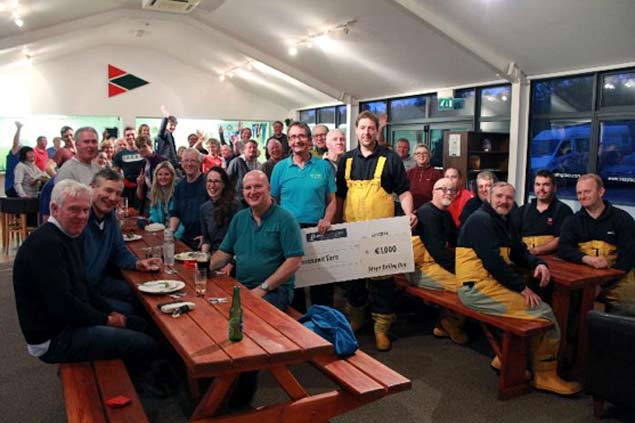 Mayo Sailing Club members and the Lifeboat crew enjoying an evening after sailing at the MSC clubhouse in Rosmoney
Mayo Sailing Club members and the Lifeboat crew enjoying an evening after sailing at the MSC clubhouse in Rosmoney
Efforts were made right after this incident to get a lifeboat for Clew Bay, where there were numerous part-time fishermen and the Clew Bay Oyster Co-operative had just been formed. Mayo Sailing Club had also just been formed, heralding the advent of an ever-increasing fleet of sail and power boats on the bay. It wasn’t however until twenty years later, in 1995, that the RNLI station at Kildavnet, Achill Island was established.
Mayo Sailing Club has been going strong ever since it was founded. With over 300 members and more than 60 boats in the harbour, MSC members love to get out on beautiful Clew Bay and beyond. Along with the fishermen in and around Clew Bay, MSC members very much appreciate knowing that the RNLI and Coast Guard have their backs. At a recent event, they gladly reached into their pockets and €1,000 was raised for the RNLI.
"Mayo Sailing Club is delighted to be associated with and support the RNLI Achill lifeboat. It is a tremendous asset and reassurance to have them here on possibly Europe's most isolated, rugged, but beautiful coastline. Well done and thank you all those who voluntarily give their time to this," Duncan Sclare, MSC Commodore
“As leisure users of the great seas that surround us it is important that we support a safe and responsible use of this fantastic resource. The RNLI are the agency of first response to boats in distress. We plan to never need to use the maritime rescue services, however, we have the security of knowing that the RNLI will react to requests for assistance and our donation is a small recognition of the great service provided by this voluntary organisation,” Conn Lavelle, MSC Sailing Secretary.
Was it luck or destiny that the weather finally, finally provided a break and the sun shone on the Mayo Sailing Club’s recent Open Day at Rosmoney near Westport? Members arrived early to mount flags and banners, stoke up the barbie, and rig the boats for demonstrations. McHale Marine set up a chandlery on site and offered discounts on marine supplies. The RNLI arrived in the Achill lifeboat, and the Coast Guard came by land, towing their rescue RIB.
Several yachts were berthed at the pontoon with owners offering a chance to come aboard for a tour, while the MSC Junior Sailing Instructors and Committee members greeted guests are they arrived throughout the afternoon. Starting at 1 pm, the Chefs of the Day began grilling hamburgers and sausages which guests scooped up for a €1 donation to the RNLI.
MSC Commodore Duncan Sclare welcomed all the visitors to the Club and explained how Mayo Sailing Club works and what activities are on offer. He explained that getting involved doesn’t require owning a boat. The Club has a fleet of dinghies that are available for Adult and Junior members to use.
Commodore Sclare noted: “The junior training programme is one of the best in the country. It is a great way to get into sailing. The Try Sailing introductory course for adults is a great way to test the waters. In includes full membership at a reduced cost. Thursday night club racing provides an opportunity to sail on club members’ yachts, and the owners are always on the look-out for enthusiastic crew.”
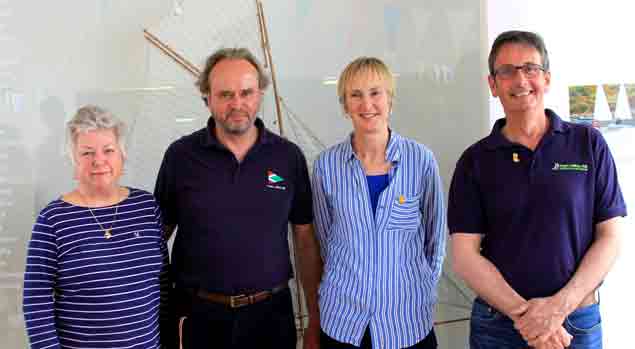 Mayo Sailing Club members Daria and Alex Blackwell, Books@One Louisburgh Volunteer Organizer Tricia Hudson, and Mayo SC Commodore Duncan Sclare
Mayo Sailing Club members Daria and Alex Blackwell, Books@One Louisburgh Volunteer Organizer Tricia Hudson, and Mayo SC Commodore Duncan Sclare
Writing Competition Awards Announcement and Prize Giving
This year, the MSC Open Day was not just about sailing. Together with Books@One, an independent Community Bookshop located far to the west in Louisburgh, Co. Mayo, and co-ordinating with the Mayo News, the Sailing Club had initiated a Children’s Writing Competition, for kids aged 9-12.
The theme was Clew Bay, and whether it was prose, poetry or a picture story was up to the author, with the prize giving scheduled to coincide with the Open Day. When a large group had assembled in the clubhouse, the award ceremony was introduced by Alex Blackwell:
“Clew Bay is so much a part of our lives here. It inspires creativity wherever we look. We thought that getting the children to express some of that creativity would be a great way to get them interested in water-borne activities, something that they might not have otherwise considered.”
Tricia Hudson of Books@One provided details of the judging process. Adjudication was independently organized by staff, volunteers and local authors involved with the bookshop, whose primary focus is children in the community. Tricia explained, “More than 200 entries were received from all around Mayo. It was so difficult to select winners from among so many very creative and well written or graphic stories and poems.”
 Patricia Hudson and Shelley Upchurch of Books@One at Louisburgh discussing the entries
Patricia Hudson and Shelley Upchurch of Books@One at Louisburgh discussing the entries
Tricia explained that all judges read all the entries. Over the course of three weeks, they selected their top choices. These were then read by all the judges. In a session in which they all met, ten were identified as stand-outs. Of those, the top five were then voted to receive prizes.
The winners were announced by MSC member Daria Blackwell, a blue water sailor and author, who encouraged the children to dream and write. “The Imagination is a wonderful place. Thank you to everyone who submitted their brilliant stories, and congratulations to all on your inspiring creativity,” said Daria as she proceeded to read out the names and hand out their well-deserved certificates.
 One of the successful authors revealed - Jason O’Connor, with his prize-winning story “The Snake of Clew Bay”
One of the successful authors revealed - Jason O’Connor, with his prize-winning story “The Snake of Clew Bay”
The top ten stories and the names of the authors are being published in The Mayo News, a partner in the Competition. The top 50 will be published in an anthology in book form which will be printed at Books@One in Louisburgh, one at a time on their Espresso Book Machine, for anyone who wishes to have a copy which will be available later this summer.
Achill Reaffirms its Status as Ireland’s Largest Island with the Help of Mayo Sailing Club
The Michael Davitt Bridge that connects Achill Island to the mainland was officially opened by leading Irish land reformer Michael Davitt on 31st August 1887, making 2017 its 130th anniversary. Construction began on a replacement Michael Davitt Bridge in 1948, and was completed a year later writes Daria Blackwell
The third Michael Davitt Bridge, which was commissioned in 2008, was a design based on a Spanish Calatrava architectural model. This swing bridge weighs 390 tons, yet it is operated manually. It’s illuminated by LED lighting integrated into the bridge design, and in the long winter nights of West Mayo, this adds to its sense of permanence.
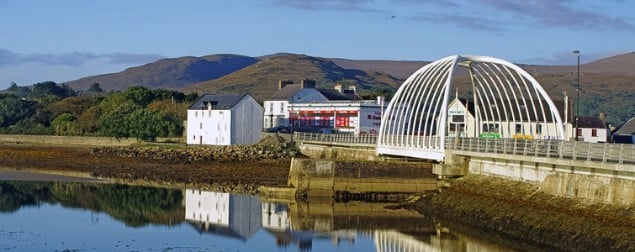 The Michael Davitt bridge at Achill Sound has an air of permanence about it, but that small central span can be opened, albeit with difficulty
The Michael Davitt bridge at Achill Sound has an air of permanence about it, but that small central span can be opened, albeit with difficulty
And the fact is, the 2008 bridge has been rarely opened since it was built. It had been too difficult to close, so it was decided that it would be better not to open it in the first place. The sheltered theoretically-available through-transit by boats with a high air-draft via narrow and tidal Achill Sound, while not actively discouraged, was certainly not promoted as a passage-making option.
This caused a dilemma for the islanders, for when it comes to Government grant aid, an island is not an “island” if connected by a fixed bridge. A long battle with the State has been ongoing since, with the Achill islanders demanding that the bridge be shown to be openable again, and this finally happened this past weekend.
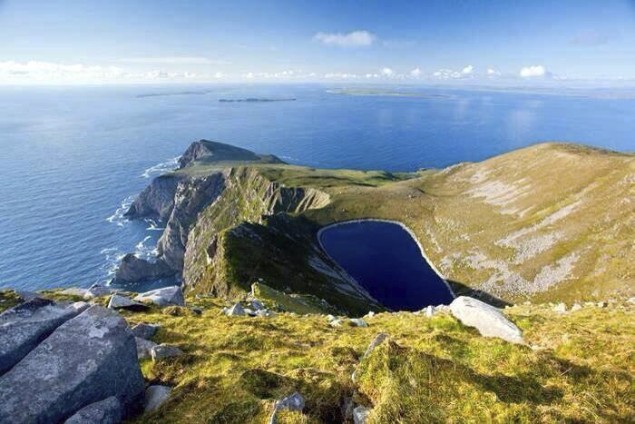 Achill Island is big country, a challenging island to sail round
Achill Island is big country, a challenging island to sail round
To mark the connection choices that Achill maintains with the mainland, a Maritime and Heritage Festival celebrating the past and present of the Achill Parish was held on Sunday the 3rd of September. As part of the festival, the bridge was scheduled to open at 5:00 pm to allow a parade of ships to pass through at high water.
Mayo Sailing Club was invited to take part. Members of the Club accepted the invitation and seized the opportunity to go one step further and circumnavigate Achill Island. Wallace Clark had written about it in Sailing Round Ireland and several members of MSC were inspired to attempt the challenge, as it had not been done in recent memory.
 The route taken by the Mayo Sailing Club fleet at the weekend
The route taken by the Mayo Sailing Club fleet at the weekend
The currents in Achill Sound run strong and swift, and shoaling is common. Mayo Sailing Club Vice Commodore Duncan Sclare organized yachts to sail from Rosmoney in a clockwise manner so they’d have a rising tide coming south through Achill Sound and still have enough water to exit the Sound beyond Corraun back into Clew Bay to return to their moorings in Rosmoney.
Navigational calculations were meticulously plotted, tides accounted for, fishermen consulted, and charts checked, as the fleet prepared to set off on the Saturday from Rosmoney. Five yachts set off on the circumnavigation. This was no small feat, as conditions on Saturday were demanding. A rough, wet and boisterous rounding of notorious Achill Head was in store for the fleet, which was subjected to 40+ knots of gusts of wind tearing down Slievemor, the second highest peak on Achill Island at 671 metres. They sought shelter for the night and holed up securely at anchor in Blacksod Bay, where good company and cold beer went down well in the pub.
 The Mayo SC fleet safely through the bridge despite the fog, and already on their way south as the tide is ebbing. Photo: Alex Blackwell
The Mayo SC fleet safely through the bridge despite the fog, and already on their way south as the tide is ebbing. Photo: Alex Blackwell
They set off in the morning to arrive at the bridge just before its scheduled opening, but a thick fog enveloped Achill and Achilbeg. Yet the project continued, even though two deeper draft vessels ran aground on the way in and had to await the incoming tide to continue on. When the time came, all five of the Achill circumnavigators succeeded in passing though the bridge, dressed for the occasion. A sixth member joined the fleet, passing under the bridge from the south and returning with the fleet, accompanied by Coast Guard vessels, rowers, and ribs, and a flotilla of the famous traditional Achill yawls making spectacular transits under sail.
 Last boat through – an Achill yawl sweeps towards the narrow gap at good speed with the sluicing tide under her…... Photo: Alex Blackwell
Last boat through – an Achill yawl sweeps towards the narrow gap at good speed with the sluicing tide under her…... Photo: Alex Blackwell
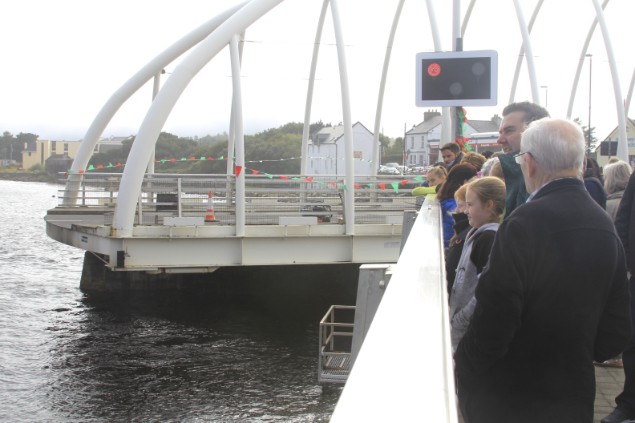 …..and almost immediately the bridge closes again………Photo: Alex Blackwell
…..and almost immediately the bridge closes again………Photo: Alex Blackwell
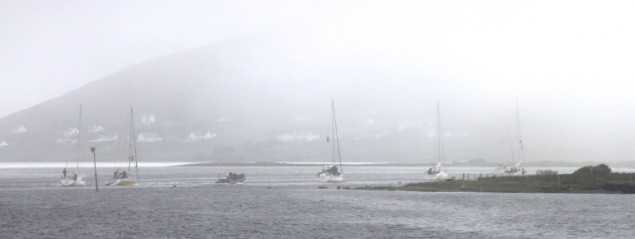 ....with the MSC fleet still in fog as they disappear down the Sound………..Photo: Alex Blackwell
....with the MSC fleet still in fog as they disappear down the Sound………..Photo: Alex Blackwell
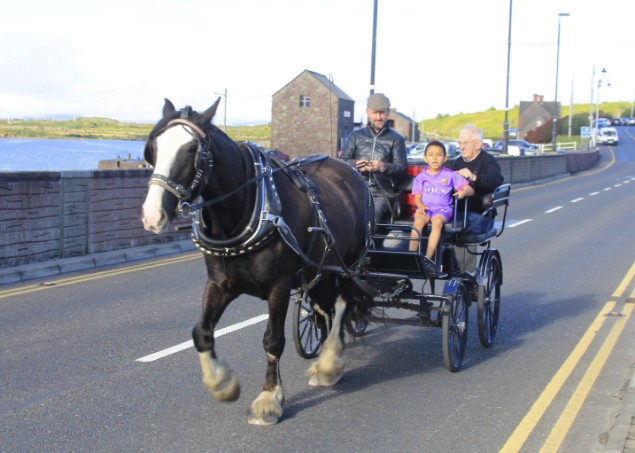 …..but back at the reinstated bridge, the sun is out, and shore transport becomes dominant once more. Photo: Alex Blackwell The crowd cheered from the bridge as each vessel passed through, and the Achill yawls then had a race in the Sound close south of the bridge in front of Alice’s Restaurant, complete with loudspeaker commentary as the evening weather finally improved for the fog to lift, and let sunshine illuminate the spectacular landscape. The day’s events were recorded by Henry McGlade for the TV show “The Irish at Home and Abroad” for an episode due to be shown on Sky TV in early October.
…..but back at the reinstated bridge, the sun is out, and shore transport becomes dominant once more. Photo: Alex Blackwell The crowd cheered from the bridge as each vessel passed through, and the Achill yawls then had a race in the Sound close south of the bridge in front of Alice’s Restaurant, complete with loudspeaker commentary as the evening weather finally improved for the fog to lift, and let sunshine illuminate the spectacular landscape. The day’s events were recorded by Henry McGlade for the TV show “The Irish at Home and Abroad” for an episode due to be shown on Sky TV in early October.
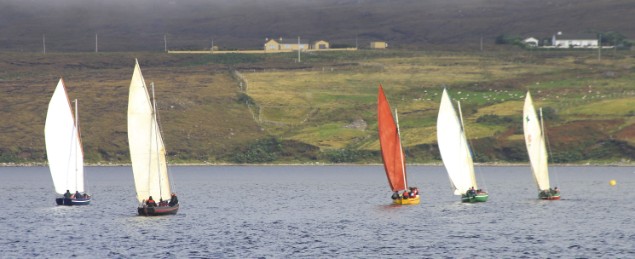 The evening sunshine strengthens as the fog continues to lift, and yawl racing gets under way in the Sound. Photo: Alex Blackwell
The evening sunshine strengthens as the fog continues to lift, and yawl racing gets under way in the Sound. Photo: Alex Blackwell
 Achill yawl racing at its best – this is going to be a cracker of a finish. Photo: Alex Blackwell
Achill yawl racing at its best – this is going to be a cracker of a finish. Photo: Alex Blackwell
But by the time the weather improved, Mayo SC fleet were well on their way, their movements dictated by the now rapidly falling tide, and it wasn’t until they were out on Clew Bay itself that the visibility began to clear properly for them, and the familiar sight of the peak of Croagh Patrick showed above the fog’s grey blanket.
Back in Mayo SC’s hospitable clubhouse at Rosmoney, Former MSC Commodore Rory Casey of the First 31.7 As Lathair commented: "One of the best sailing weekends I've ever had - we had a bit of everything. Why do we have to travel to the ends of the world, when we have this adventure sailing here on our doorstep?"
 Out on the open waters of Clew Bay, it took longer for the fog to lift, but the MSC fleet got the reassuring sight of Croagh Patrick above the fog blanket as they headed for home after a successful weekend circumnavigation of Achill Island. Photo: Rory Casey
Out on the open waters of Clew Bay, it took longer for the fog to lift, but the MSC fleet got the reassuring sight of Croagh Patrick above the fog blanket as they headed for home after a successful weekend circumnavigation of Achill Island. Photo: Rory Casey
Vice Commodore Duncan Sclare, who made the circuit on one of the smaller boats, the Achilles 30 Freebird, summed it up: "On this circumnavigation of Ireland’s largest island, we experienced it all: Flat calm, Atlantic seas, howling winds, rain, sunshine, fog, tricky navigation, an unopenable bridge that opened, and great company. A voyage that will be remembered a lifetime."
The Mayo Sailing Club boats whose crews now cherish very special memories of the first weekend of September 2017 in proving that Achill is indisputably an island were: Freebird, As Lathair, Xena, Misty, Enya, and Eabha Marie.
Galway Bay Yacht 'Tribal' Wins WIORA Overall Prize
#wiora – The 2014 West of Ireland (WIORA) champion is Tribal, Liam Burke's Galway Bay Sailing Club based Corby 25 that produced four wins from seven races in last week's WIORA championships at Mayo Sailing Club. Burke's scoreline was good enough to win class 2 IRC ahead of top Foynes contender Dis–A–Ray, a Dehler 34, and take the overall award too, in a series that had everything from flat calms, forked lightning plus some very good Clew Bay breezes to boot.
IT was a "WIORA West Coast Championship to remember..."
That is how Simon McGibney, Commodore of the association described the 2014 West Coast Championship event hosted by Mayo Sailing Club in the waters of Clew Bay.
While Team Ireland was taking honours at the Commodores Cup in the UK, the Irish domestic sailing community on the west coast was battling it out for the 2014 WIORA title under the stunning backdrop of Croagh Patrick leaving everyone wowed by the experience.
And that is certainly how the 200 or so competitors felt leaving the event after Tribal, sailing out of Galway Bay Sailing Club, lifted the coveted trophy as overall winner of WIORA 2014. A worthy title holder in an event where everyone was victorious in some way shape or form.
But it was Liam Burke's Corby 25 that won four of the seven races in Class two and was always staying in the mix by adding a 2nd and 3rd on Day 3 and 4 of the event that was enough for the Galway boat to take the honours in what was a hotly contested division.
Tribal and its crew now take the title back to Galway Docks where the 2015 event will be hosted by their home club of GBSC.
Race Officer Alan Crosbie, on receiving a small presentation from the Eoghan Cunningham, Commodore of Mayo Sailing Club, said it is an event he loves to see coming around every year, "and one I will not miss, because when I get the call I just say yes straight away." WIORA he said, "is a great event close to my heart".
On hosting the event, the ever popular MSC Commodore Eoghan Cunningham said that in the lead up to WIORA, "I was dreading it, but now I just don't want the week to end".
Receiving a huge round of applause, the WIORA sub committee at Mayo SC, together with Eoghan at its head were praised for their hosting of the event – even the little things like all the race competitors being delivered choc ices on Friday while drifting on the waters of Clew Bay under the summer sun as the crews waited for the breeze to fill in – to a care package of cold beers delivered to every boat as they completed the long coastal race at the conclusion of the event – will go a long way to indeed making WIORA 2014 one to remember.
Congrats to all at Mayo Sailing Club, to the helpers, to the race officers and flag boat crew, to the rib drivers, to the staff at the club house, to the WIORA committee, to the competitors that raced in every possible weather condition including thunder and lightening, to those ashore that waited and supported and to those that we forgot – we thank you and we look forward to meeting on the water again soon and if not, certainly back at Galway Docks in 2015 when the battle will commence to see who can take the West Coast Championship title off the crew of Tribal.
WIORA West Coast Championship 2014 Winners
Overall WIORA West Coast Championship Winner Tribal (GBSC)
Class 1 IRC Winner Now What (GBSC)
Runner Up TK Lean Machine (GBSC)
Class 2 IRC Winner Tribal (GBSC)
Runner Up Dis-A-Ray (TIMC)
Class 3 IRC Winner Boojum (TBSC)
Runner Up Django (RWYCI – LRYC)
Class 1 ECHO Winner TK Lean Machine (GBSC)
Runner Up X-Rated (MSC)
Class 2 ECHO Winner Dis-A-Ray (TIMC)
Runner Up Elixir (MSC)
Class 3 ECHO Winner Subadar (MSC)
Runner Up Privateer (MSC)
White Sails Winner As Lathair (MSC)
Runner Up Xstatic (MSC)
BJ Marine cup Genie
X-Yachts cup X-rated,
Tommy OKeeffe trophy Dis-A-Ray,
Next year's WIORA moves to Galway and in 2016 the event is heading back to Kilrush on the Shannon Estuary.
Full WIORA results are on the Mayo Sailing Club site HERE
Mayo Sailing Club Hosts WIORA West Coast Championships
#WIORA - The West of Ireland Offshore Racing Association’s (WIORA) West Coast Championships will be held on Clew Bay from Wednesday 23 to Saturday 26 July 2014.
As reported last October on Afloat.ie, Mayo Sailing Club in Rosmoney will play host to the fleet of up to 30 boats from around the country that will vie for the coveted titled of 'Champion of the West'.
The main attraction will be preceded by a week of events starting with the O’Sullivan's Marine 100 Mile Race the weekend before the West Coast Championships, on a course set from the Aran Islands in Galway Bay to Mayo Sailing Club.
Meanwhile, charter boats are available all around Clew Bay to get the best views of the action while doing some fishing, having a picnic on board or just enjoying being out on the water and taking in the sights.
You can also meet the skippers and crew at the daily after-race party at Mayo Sailing Club, where there will be food, teas and coffees, entertainment and an open bar.
Live music will be provided by the Hip Pocket Trio and their jazz soul stylings on Wednesday 23, singer-songwriter Dennis McCalmont on Thursday 24 and pop-rocking three-piece Old Tricks on Friday 25 July.
#mayosailingclub – For two weeks in a row, Mayo Sailing Club has exposed loads of new people to sailing and fun on the water in the west of Ireland. If the smiles and peals of laughter are any gauge, the effort has been quite the success.
At the May Bank Holiday weekend, a number of the club's boats sailed off to Inishturk to visit this very special island for the weekend. They brought with them a fleet of sailing dinghies and a rescue rib, along with life jackets, and instructors – everything needed to get the islanders safely out on the water.
Despite dire forecasts, the weather cooperated with the winds decreasing and rain holding off through the afternoon on Saturday. As the sailboats anchored and moored in the harbour, the dinghies were brought over on a trailer by ferry. The dinghies were rigged around noon and Inishturk resident children and adults were given the opportunity to try sailing under the supervision of experienced sailors in the magnificent harbour.
Mayo Sailing Club Commodore Eoghan Cunningham ran a tight programme and operated the rib, which facilitated crew changes out on the water and allowed him to keep a close eye on the sailors and assist when needed. The buzz in the Community Club house afterwards was electric. Exuberant young sailors told their stories to parents and friends while the cruisers listened in and rejoiced over the new passion instilled.
The success of this inaugural venture means that the dinghies will be brought out to other islands scheduled as stopovers for the Mayo Sailing Club fleet during the course of the summer. The next cruise in company is to Clare Island and takes place June Bank Holiday weekend. As always, non-members are very welcome to join in.
On Sunday 11 May, Mayo Sailing Club opened its doors in Rosmoney to welcome non-members for a day of family fun out on the water. The dinghy fleet was once again brought out and rigged allowing guests to try sailing for the first time with experienced sailors at the helm. This time, the larger cruising sailboats were also at the ready on the pontoon and took anyone interested in sailing on a 'big' boat out onto Clew Bay. Fast ribs were also available to take visitors on a thrilling spin. Adventure Islands provided lessons in their new archery offering on club grounds. A free barbeque meal and hot showers ended the day on a high note. Once again the weather gods cooperated with (mostly) sunshine and (mostly) gentle breezes after a week of high winds and heavy rains.
Liam Mac Réamoinn, Junior Organiser, expressed his thanks to all those who helped make the sailing initiative such a success. The exciting day prompted the Committee to decide to open the sailing club to its members every Sunday afternoon at 3 pm for dinghy sailing. The fleet of dinghies will be available for rental to club members at nominal hourly rates to cover the cost of repairs. Mayo Sailing Club now have more ways you can join and get out on the water without even owning a boat.
Mayo Sailing Club members have been very active and successful on the racing and cruising circuit and have been attracting attention on a nationwide and global scale. This year, the Western Sailing Championships are coming to MSC and will be sailed on magnificent Clew Bay the last week of July.
This is a big event and will provide quite a spectacle on the Bay. Mayo Sailing Club is honoured to be the host of such a prestigious event. Visit the Mayo Sailing Club website
Mayo Sailing Club to Run WIORA West Coast Championships in July
WIORA's 'West Coast Championships' will take place from Wednesday, 23rd July to Saturday, 26th 2014, and will be hosted by Mayo Sailing Club at Rosmoney, on Clew Bay. A fleet of up to 30 boats will take advantage of the new pontoon facilities near the club house.
Rosmoney near Westport is the base for the Sailing Club whose members enjoy the excellent sailing grounds that exists among the archipelago of islands in the east of Clew Bay.
The important new pontoon facility is located approximately 30 metres from the edge of the permanent pier and has been in constant use by Mayo Sailing Club, islanders, boatmen since it opened in April 2013.
'The Rules of Racing' Lecture in Castlebar This Thursday
#RACING - Mayo Sailing Club's winter series of lectures continues this Thursday 23 February with a talk by Ed Alcock on 'The Rules of Racing'.
Alcock is racing manager of the Irish Sailing Association (ISA), and his lecture will outline the laws that govern racing by windpower on the water in Ireland, covering classes from yachts and dinghies to windsurfing, kitesurfing and more.
Topics to be covered include rights and obligations on the water, giving way, keeping clear, red flags and protest forms.
Sailors of all craft are invited to attend the evening, and anyone wanting to get involved in racing is also welcome, especially with the 2012 racing season only eight weeks away.
Alcock's talk takes place this Thursday at 7.30pm in GMIT Castlebar. The Galway Advertiser has more HERE.




























